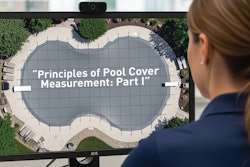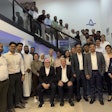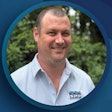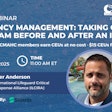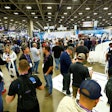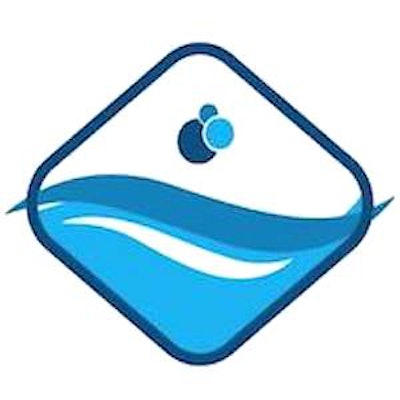
For Trevor Sherwood, owner of the training organization Pool Operation Management, the value of ongoing professional development in the aquatics industry couldn’t be more clear. Fortifying his own convictions, he’s heard firsthand from successful entrepreneurs who’ve bought into the model of incorporating robust employee education into their business models.
Sherwood remembers a person who came up to him after a training session and asked for advice. After working within a different company for several years, the questioner had recently struck out on his own and wanted to know what strategies should be prioritized as he built his new business from the ground up.
Sherwood stressed the importance of developing a well-educated staff, including securing certifications that solidified a commitment to the best work possible. Investing in education, Sherwood told him, would be the most effective way to grow the new company. It was a while before Sherwood saw him again, but when the two next met, the change in fortunes had been dramatic.
“When I first spoke to him, he had a handful of pools,” recounts Sherwood. “When I saw him five years later, he had almost 150 accounts and a fleet of guys working under him.”
The investment paid off.
THE TASK AT HAND
Education efforts have been at the forefront of the conversation surrounding this year’s merger of the Association of Pool and Spa Professionals with the National Swimming Pool Foundation, forming the new Pool and Hot Tub Alliance. Many in the industry count on the certification programs and other professional development efforts offered by the trade associations. In a time of organizational flux — and therefore uncertainty — there have been a lot of questions about which programs will still be available as the group’s new identity gels.
One thing is certain: Education programs aren’t going away. There’s a clear understanding of the value a strong professional development apparatus brings to the entire aquatics industry. The convergence of the two organizations does provide a clear opportunity to make revisions for the better, though. And PHTA aims to take advantage of the situation.
RELATED: Promote and Inform: How PHTA Affects Change from D.C.
One of the first moves by the PHTA board of directors was the formation of an education task force comprised of professionals and thought leaders from across the industry.
“The task force is evaluating all of the educational programs offered by both the former APSP and the former NSPF,” explains Silvia Uribe, director of education for PHTA. “The goal is providing input on things, such as creating new courses.”
In addition to representation that touches upon just about every professional area represented in the pool and hot tub industry — manufacturers, retailers, pool managers and technicians among them — the task force was drawn equally from the longtime collaborators with both preceding organizations. In the delicate process of intertwining the groups, neither history will be forgotten.
According to Jack Manilla, president of Portofino Pool Services and Outdoor Living and president of Portofino University, the task force is fully committed to ensuring PHTA builds on the established and effective education programs already in place.
“The goal of the task force is to raise the bar on education for industry,” Manilla says. “We don’t anticipate the wholesale removal of existing programs. The intent is to grow the offerings. We’re looking to create the gold standard for the industry globally.”
EDUCATION EVOLVES
Although there’s agreement about preserving the hard work that’s been done to bring industry educational opportunities to the current point, there are still challenges. The plan is to provide a certain uniformity of basic structures and interfaces to the PHTA learning, which requires aligning two different systems created and designed for unlike platforms.
The task force doesn’t want to create disruption by rushing the process. The revised, streamlined PHTA model will take time to come to fruition.
“It’s a work in progress,” says Robert Blanda, owner of Mill Bergen Pools, who also sits on the PHTA education committee and the education task force.
Luckily, many of the education tools were already in the process of evolving. There’s been a concerted effort in recent years to take advantage of more dynamic technologies to establish courses offered online and with other digital infrastructures. Rather than the classroom model, which often required businesses to pay for staff travel to conferences and other sites where instructors would convey information in an intensive few days, the move has been toward online modules, allowing learners to pick and choose their topics, study at home or in the office and go at their own pace.
Sherwood, who also sits on the task force, spells out the dramatic difference between the new educational model and the old.
“In years past, you might do a ride-along with the owner for a week where they’d show you what to do, and then you’re on your own and everyone hopes for the best,” he says. “Now, people get trained in a much more deliberate way. In addition to providing a sturdier foundation for the worker, I think it instills a sense of pride. They’re getting an education from their employer, which feels good to the employee because it’s a true investment in them.”
RELATED: PHTA Announces New President/CEO
The standardization of teaching and learning models from a national organization makes a difference, too. In the previous approach of haphazard mentoring, poor practices were often passed down, perpetuating faulty operating procedures in the industry. As a result, some of the most tedious and frustrating work a pool or hot tub company might take on would involve cleaning up messes left by their subpar competitors.
Constructing curriculums on digital platforms also allows for quicker, more nimble adjustments as the industry and its regulations shift. In turn, the pliability of the tools should make it much easier for PHTA to make the adjustments recommended by the education task force.
“Before the education programs were digital, it was very complicated to make changes,” notes Blanda. “Now that it’s digital, these things are all living documents. The ability to update the material was built in.”
A LONG CAREER PATH
The unified vision and mission of PHTA is further reflected in one of the major goals the education task force has already settled on. The membership has expressed concerns about the major challenge in retaining workforce in the current job market. Too many people who enter the pool and hot tub industry simply don’t see a future in it.
“A lot of the millennials are very focused on finding a career that’s going to make them happy,” Sherwood says. “When they enter an industry, they want to make sure that there’s room for advancement.”
The education task force has been thinking about ways they can incorporate deeper workforce development into the courses. Students need to understand the basic mechanics of the industry, but there’s also a clear need for sharp, thoughtful career path programs, giving workers a sense of the ways in which they can achieve personal and professional development if they stick in the field.
“In our company, we developed career-pathing programs,” Manilla says. “We talked to our employees, making them aware that there are opportunities for upward advancement within the industry and within our own company.”
Manilla is among those championing a similar mindset as the PHTA education programming is reshaped.
“Conceptually, the idea is to end up with all these different tiers of education: entry level, middle of the road, journeyman, working all the way up to advanced roles,” explains Manilla.
Younger employees recognize the ways in which training represents an investment on their behalf. They see the company putting time, effort and money into providing them with educational opportunities. As a result, they feel valued.
It’s also important for owners and managers to provide reminders of the more tangible benefits that are likely to come with professional betterment.
“Acquiring new skills and moving to positions with greater responsibility often comes with additional income for the employee,” Manilla notes. “There are plenty of jobs in the industry they can aspire to: manager, foreman or even director or vice president. You can lay out a pretty good long-term career path.”
RELATED: PHTA Establishes Education Plan, Seeks New CEO
The full career path model already has some promising pieces in place. The organization recently introduced coursework for retail employees, who were often overlooked when planning education. CRP 101, a course covering core principles, offers the basics of customer service and water chemistry as well as pool finishes, pool and spa circulation systems, retail environmental safety and other best practices in sales and retail work.
Advanced development is provided by CRP 201. “We were clearly told there is nothing in the industry right now for those retail employees that stay with the company and want to develop professionally,” says Uribe. “And that’s where CRP 201 comes in. It provides instruction related more to the administrative and management component of a retail store. We cover human resources, OSHA regulations, finances, really all the tools an employee needs to move forward with their career in a retail store.”
Artfully progressive coursework such as that is just the beginning.
“We would like to create an education path that’s just like college,” says Blanda. “Students will develop expertise with an option to keep going and building on their knowledge.”
BUILDING BETTER RESOURCES
Investing in education obviously strengthens a company’s staff, and that helps the bottom line.
“It saves me money as an owner when my guys don’t have to go back to job sites to fix mistakes,” says Sherwood. “I don’t need to send a third guy to go take a look at it. The first person we’re sending is educated enough that they can look at the job and do it right. It just saves money for us, and it saves money for the customer.”
Having a well-trained workforce also reflects on a company as a whole and establishes customers who are satisfied with the expertise of the employees they encounter. Approached wisely, the commitment to education becomes a critical part of the story told to the consumer.
“You want to know what sets us apart from another company? Our people are certified,” says Sherwood. “It’s in our advertising: All our people are certified.”
Sherwood also feels that setting certifications as an industry norm will help make everyone’s business stronger. The more companies tout the officially recognized skills of their workers, the more skeptical consumers will be of fly-by-night companies touting lowball prices to get a quick job. The lack of certification will be a warning sign, driving those bad actors from the marketplace. Sherwood forecasts a stabilization of prices at a fair rate for all companies.
To reach that aspirational point, the educational tools need to be readily available, fully up to date and unerringly thorough. Everyone agrees reaching the goal will be challenging, but the will is there to keep building on the best options already in place.
According to Uribe, the melding of APSP and NSPF into PHTA will hasten the arrival of the ideal educational model for the pool and hot tub industry.
“Prior to the merger, both organizations were looking at advancing aquatics knowledge and skills, but separately,” she says. “Separately, it was going to take a lot of time, a lot of energy, a lot of resources. The merger opens a window of opportunity to have new courses and new curriculums move forward. Instead of a proposition of planning for 10 years down the road for major changes, we feel the time shortens before we can build a more extensive portfolio.”



























